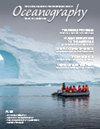仅使用环境光捕获低光水生栖息地图像的光学成像系统。
IF 2.8
4区 地球科学
Q1 OCEANOGRAPHY
引用次数: 2
摘要
S1.部署和水下作业2018年7月10日至23日,光学成像系统(OIS)部署在南拉霍亚州海洋保护区(SMR;32.8263°N,117.2901°W)北部边缘的海带林中,水深约14米(图S1a)。它在05:00至21:00(即日出前和日落后至少一小时)之间每12分钟拍摄24张图像,以确保图像采集不会错过潜在的可用光照条件。图像是在光圈优先模式(光圈:f2.8)下拍摄的,作为未压缩的原始图像文件,纵横比为16:9。镜头在空中的焦距设置为0.3米,这样水中距离相机一米远的鱼就会对焦。这是使用Jenkins和White(2001)中的方程来计算厚透镜的聚焦距离来确定的,我们在GitHub存储库中包含了一个MATLAB R2016b(MathWorks,Natick,MA)脚本来计算这一点(https://github.com/cpagniel/FishOASIS/blob/master/hardware/FishOASIS_lens_focusing_dist_code.m)。每个图像的ISO(国际标准组织)灵敏度由相机自动设置在50到409600之间。白平衡也是由相机自动设置的。OIS由潜水员安装在一个L形支架上(用于景观图像),该支架位于一个50×50×10cm混凝土块中的1米高的u形支柱上(图S1b)。它也可以直接安装在支架上进行人像拍摄。电池组放置在混凝土块上,电缆系在混凝土块中的两个吊环螺栓上。HOBO Pendant温度/光线8K数据记录器(Onset Computer Corporation,Bourne,MA)连接到相机外壳上,用于测量海水温度(单位:°C)和环境光线(单位:勒克斯)。为了校正环境光谱,DGK彩色工具WDKK防水彩色图被部署在距离相机2米的视野中。为了近似鱼类与相机的距离,使用样带测量了与相机图像中始终可见的各种静止物体(例如岩石、海带固定物、煤渣块)的距离。为了证明OIS将其时钟与被动声学记录器同步的能力,OIS与SoundTrap ST4300(新西兰奥克兰海洋仪器公司)四通道声学记录器一起部署。该记录器配备了一个光学成像系统,用于仅使用环境光在弱光水生栖息地捕获图像本文章由计算机程序翻译,如有差异,请以英文原文为准。
An Optical Imaging System for Capturing Images in Low-Light Aquatic Habitats Using Only Ambient Light.
S1. DEPLOYMENT AND UNDERWATER OPERATION The optical imaging system (OIS) was deployed in the kelp forests on the northern edge of the South La Jolla State Marine Reserve (SMR; 32.8263°N, 117.2901°W) in approximately 14 m water depth from July 10 to 23, 2018 (Figure S1a). It captured 24 images every 12 minutes between 05:00 and 21:00 (i.e., at least one hour before sunrise and after sunset) to ensure that no potentially usable light conditions were missed for image acquisition. Images were captured under aperture priority mode (aperture: f2.8) as uncompressed, raw image files with a 16:9 aspect ratio. The focusing distance of the lens was set at 0.3 m in air so that a fish one meter away from the camera in water would be in focus. This was determined using equations in Jenkins and White (2001) to compute the focusing distance for thick lenses, and we have included a MATLAB R2016b (MathWorks, Natick, MA) script to calculate this in the GitHub repository (https://github.com/cpagniel/FishOASIS/blob/master/hardware/FishOASIS_lens_ focusing_dist_code.m). The ISO (International Standards Organization) sensitivity of each image was automatically set by the camera between 50 and 409,600. The white balance was also automatically set by the camera. The OIS was mounted by divers to an L-bracket (for landscape images) on a 1 m tall u-post set in a 50 × 50 × 10 cm concrete block (Figure S1b). It could also be mounted directly to the stand for portrait images. The battery pack was placed on the concrete block and cable-tied to two eyebolts set in the concrete block. A HOBO Pendant temperature/light 8K data logger (Onset Computer Corporation, Bourne, MA) was attached to the camera housing to measure seawater temperature (in °C) and ambient light (in lux). To correct for the ambient light spectra, a DGK Color Tools WDKK Waterproof Color Chart was deployed in the field of view of the camera at a distance of 2 m. To approximate the distance of fishes from the camera, distances to various stationary objects always visible in the images (e.g., rocks, kelp holdfasts, cinderblocks) from the camera were measured using a transect tape. To demonstrate the OIS’s ability to synchronize its clock with that of a passive acoustic recorder, the OIS was deployed alongside a SoundTrap ST4300 (Ocean Instruments, Auckland, NZ) four-channel acoustic recorder equipped An Optical Imaging System for Capturing Images in Low-Light Aquatic Habitats Using Only Ambient Light
求助全文
通过发布文献求助,成功后即可免费获取论文全文。
去求助
来源期刊

Oceanography
地学-海洋学
CiteScore
6.10
自引率
3.60%
发文量
39
审稿时长
6-12 weeks
期刊介绍:
First published in July 1988, Oceanography is the official magazine of The Oceanography Society. It contains peer-reviewed articles that chronicle all aspects of ocean science and its applications. In addition, Oceanography solicits and publishes news and information, meeting reports, hands-on laboratory exercises, career profiles, book reviews, and shorter, editor-reviewed articles that address public policy and education and how they are affected by science and technology. We encourage submission of short papers to the Breaking Waves section that describe novel approaches to multidisciplinary problems in ocean science.
 求助内容:
求助内容: 应助结果提醒方式:
应助结果提醒方式:


